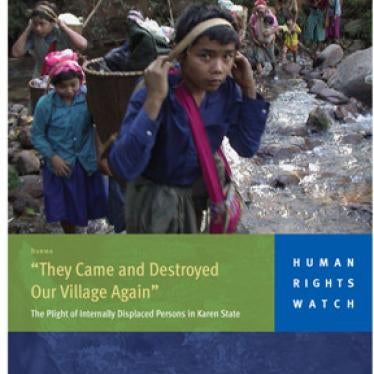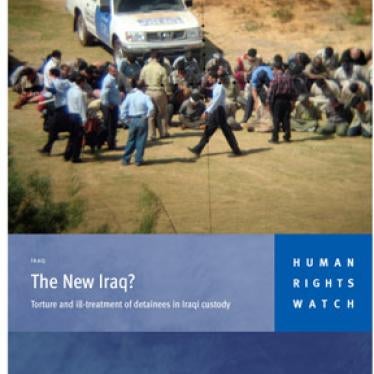(New York) - Thousands of Burmese civilians forced to flee from army attacks in Karen state are trekking through free-fire zones in search of safety and food aid, Human Rights Watch said today. More than 200 civilians have reached camps near the Thai border, but another 3,000 are still on the move, according to credible recent reports received by Human Rights Watch.
In Karen state, a year-long military offensive against Karen resistance fighters has displaced 27,000 civilians, with at least 45 civilians killed by government forces. Recent attacks have killed seven villagers and forced more than 1,450 to flee in Mon Township of Nyaunglebin District in eastern Burma. Across the country, more than 82,000 have been forced to flee conflict.
“The Burmese military attacks villages, uses civilians for forced labor and steals their food and money, forcing people to flee,” said Brad Adams, Asia director at Human Rights Watch. “But the military campaign also prevents villagers from eking out even the meanest existence. The military acts like an occupying army, using the population as expendable pawns.”
Human Rights Watch has received recent reports that more than 200 civilians have arrived at settlements for the internally displaced close to the Thai border, such as Ei Tu Hta. Most had walked for 17 days through free-fire zones to reach safety and receive food aid. Some 3,000 civilians are reportedly moving toward the border settlement in dangerous conditions, because food shortages resulting from Burmese army operations forced them to flee.
Human Rights Watch has documented patterns of displacement in Karen state and interviewed many people who have fled from Burmese army oppression and violence. There is clear, reliable evidence that civilians are being punished as a military strategy. Since the start of 2006 alone, 232 villages have been destroyed in Burma as part of the army’s campaign against ethnic insurgents, and 82,000 people have been forced to flee as a direct result of armed conflict.
Human Rights Watch called on the Burmese Army to end its attacks on Karen villagers and to stop the other abuses prompting a new wave of internally displaced people.
In September 2006, the Burmese army introduced new light infantry divisions into northern Karen state, apparently preparing to prevent civilians from harvesting their crops. Human Rights Watch warned of grave concern for the food security of the local population if the army attempts to disrupt the harvest in order to take over food stocks for its troops. The army has previously taken measures to disrupt the harvest, including laying thousands of landmines around houses and fields to deter civilians from approaching their villages and crops.
“The Burmese army is driving thousands toward the border with Thailand and herding villagers into squalid relocation sites or into the jungle away from their ruined homes and dying crops,” said Adams. “It’s no wonder that thousands of Burmese have to flee from their own army.”
Since 1996, it is estimated that 3,077 villages have been destroyed by the army and more than 1 million people displaced. More than 500,000 civilians are living as internally displaced people along the eastern Burma border with Thailand, but this figure likely underestimates the true numbers, since some areas are too dangerous to survey.
The findings of the annual internally displaced persons (IDP) survey by the Bangkok-based Thailand Burma Border Consortium (TBBC), a humanitarian group, released last month, concluded that militarization and Burmese army human rights violations are the major factors behind internal displacement in Burma. There are three main types of internally displaced populations in eastern Burma. The most desperate are an estimated 95,000 people hiding out in conflict zones, with limited access to food, health and education. Around 287,000 civilians are said to be sheltering in dozens of locations in areas where the army and ethnic insurgents have called ceasefires. The third group, people forcibly removed from villages destroyed by government forces, are living in government-controlled relocation camps. The 118,000 people estimated to be living in these camps are often used as an easy pool of labor and food supplies by Burmese army soldiers.
The 2006 TBBC estimate of how many people are considered to be internally displaced is slightly lower than last year; this may be due to the difficulty of accurately assessing numbers when many people are hiding out in rugged terrain or gravitating toward urban centers in search of food and work. Many people continue to live in desperate circumstances with little international assistance.
The agony of internal displacement is exacerbated by the dire health situation in eastern Burma. Recent surveys show that health indicators among the displaced population are some of the worst in the world, with 12 percent of the population suffering at any time from the most serious form of malaria, widespread malnutrition, high risk of injury from landmines and armed conflict, and high rates of infant mortality. These highly vulnerable populations receive little if any international assistance.
Human Rights Watch said the army attacks continued even as Ibrahim Gambari, the UN undersecretary-general for political affairs, visited Burma this month for talks with senior leaders. The United States is seeking a Security Council resolution calling on Burma to end attacks on civilians and to stop causing displacement, among other things.
“Even with Burma on the UN agenda the army continues to attack its own people,” Adams said. “But civilians shouldn’t be paying the price for the military’s war against insurgents.”







